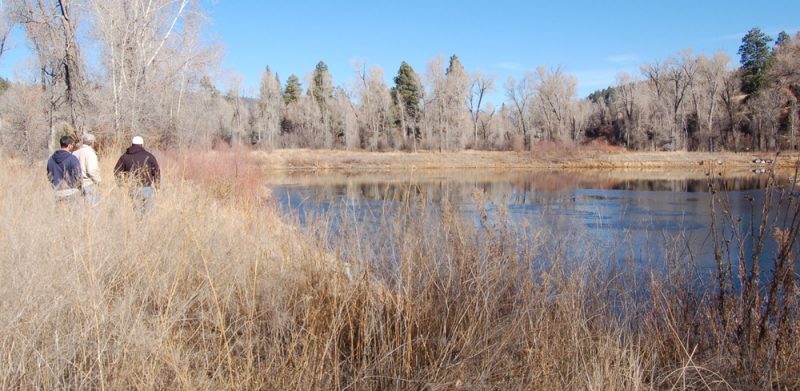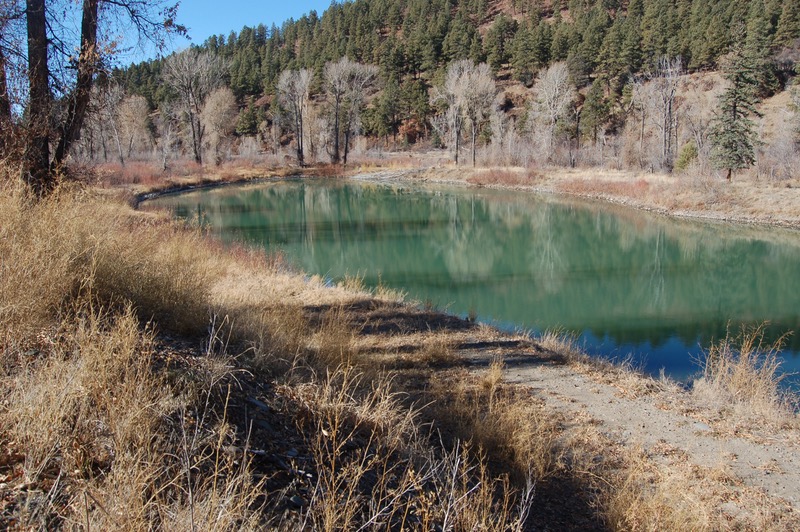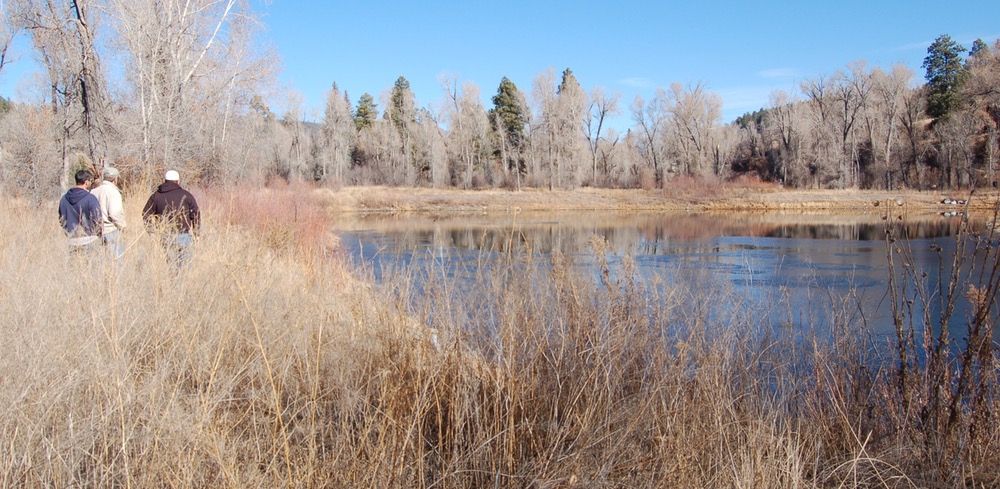November 12, 2019.
At the end of a short dirt road — not an improved gravel road, but a plain old utilitarian dirt road — we came upon a good-sized, man-made lake that had resulted from the Weber family’s gravel mining operations, about a mile north of downtown Pagosa.
If you didn’t know it was a former gravel mining operation, and if you didn’t know much at all about gravel mining (which I don’t), you might think this was a natural setting, rather than a reclaimed gravel mine. Wild grasses and shrubs grew all around the lake.
The sound of the San Juan River could be heard nearby. I would describe it as a peaceful place.

Our host on the tour was long-time Pagosa resident Kathy Weber, representing Weber Ranches LLC, Weber Sand & Gravel, and Hard Times Concrete. (I understand Kathy Weber is also an author; one of her hard-to-find books is titled Cattle Camp Cookie: A Treasury of Western Ranches and Recipes.)
Lucas West, Environmental Protection Specialist with the Colorado Division of Reclamation, Mining and Safety, had driven down from Grand Junction to verify that the Weber family had fully completed the reclamation process, to the standards required by the state government. To judge by Mr. West’s comments during the visit, the Webers had done an outstanding job with the restoration of the site.
Justin Ramsey, district manager with Pagosa Area Water and Sanitation District (PAWSD) nodded in general agreement.
Al Pfister, a retired biologist, was representing the San Juan Water Conservancy District (SJWCD) on yesterday’s tour, and he echoed the comments made Mr. West. He said he’d worked on numerous reclamation projects during his career, and this particular restoration represented the type of outcome he wished he’d seen on other mining sites.
Actually, we had visited two gravel mining sites yesterday. A few minutes earlier we had reviewed another site, near the southern end of that dirt road, which had also been operated by the Weber family and then reclaimed. It too had resulted in a small lake. More like a pond, perhaps.

This other mining site is located on property that the Webers had sold to our two local water districts — PAWSD and SJWCD — back in 2008, when the boards of the two water districts were planning to build the Dry Gulch Reservoir on the Webers’ Running Iron Ranch, across the highway. As part of the 2008 sales contract, the water districts allowed the Weber family to continue ranching and mining gravel on the property for the next 15 years. As I understand it.
I’ve been told, that agreement expires in 2023.
The two districts are still planning to build the Dry Gulch Reservoir, although SJWCD now refers to the project as the “San Juan River Headwaters Project.” PAWSD, which originally took the lead in planning and financing the proposed reservoir, has since assigned project leadership to SJWCD. (Disclaimer: I serve on the SJWCD board.) The Colorado Water Conservation Board (CWCB) has also made a financial investment in the project, in the form of a $10 million loan to PAWSD and a $1 million grant to SJWCD. Those CWCB investments have thus far helped to ensure that the project remains at least theoretically possible.
This particular visit had very little to do with water resources, other than the lakes and ponds that might ultimately result from expired gravel operations.
During the tour, the four other people in the party — the four who actually know something about gravel mining — chatted in a friendly way, and some of the comments related to the gradual disappearance of commercial gravel mining in Archuleta County.
I recall someone saying something like:
“The people who are moving to Pagosa Springs don’t understand how important gravel is.”
Someone else commented that the cost of maintaining our roads, and the cost of construction in general, is sure to continue climbing out of sight if new gravel operations can’t be located and developed. In particular, we have a pressing need for high quality gravel — the kind of gravel that can take a beating.
Presumably, traditional ranching families like the Webers, who have had to maintain their own private roads across their ranches, have an appreciation for gravel, and the work involved in obtaining that gravel.
As we stood beside the smaller pond — the one that will now belong to PAWSD and SJWCD — I asked Ms. Weber if she knew how many tons of gravel her family had excavated from that pit. She didn’t know.
When I spoke with Archuleta County Public Works Director Bob Perry last summer, I asked how many tons of gravel the County uses when repairing a worn-out gravel road, and I was told that, typically, we need about 3,500 tons of crushed gravel to treat a mile of road. We pay $11 a ton for good quality gravel, he said… so we might estimate that a mile of road requires about $38,500 worth of gravel. How often? Every couple of years, on a busier road?
If the price of gravel were to increase by, say, 25 percent… well, the County would need to increase our Road & Bridge budget for gravel by 25 percent, just to stay even.
“Staying even” would mean, in Archuleta County, “getting further behind.”
As we noted in yesterday’s editorial, the Archuleta Board of County Commissioners, in their proposed budget for 2020, reduced the percentage of the General Fund revenues going towards road maintenance from 25% of the General Fund, down to 5%.
What we really needed, apparently, was a $14 million jail.

